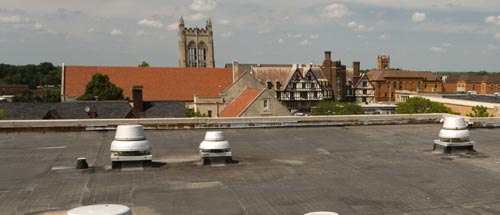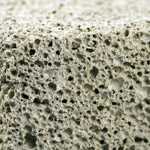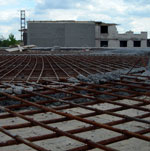
When it comes to a concrete roof, no one wants to be the person telling everyone the sky is falling. However, when it comes to many commercial roofing installations, contractors and installers become the cause for that kind of alarm by not using the correct (or any) moisture test method for the concrete that forms the foundation or deck for the roof structure. The concrete deck is integral to each roofing system, and without accurate moisture testing before the finish materials are installed, the entire system can be put at risk.
1. All concretes are not created equal.
 Moisture levels in any concrete slab are affected by a number of conditions and therefore a final drying time cannot be predicted with any certainty outside of accurate moisture testing. Most concrete roof decks make use of lightweight concrete mixes; a big benefit to the load weight of the structure, but a drawback in terms of accurately measuring the relative humidity of the drying deck because certain test methods have proven inaccurate. The initial concrete mix, the chemical interaction of admixtures, and the ambient relative humidity or temperature variations all contribute to the rate at which moisture can exit (or enter) the slab.
Moisture levels in any concrete slab are affected by a number of conditions and therefore a final drying time cannot be predicted with any certainty outside of accurate moisture testing. Most concrete roof decks make use of lightweight concrete mixes; a big benefit to the load weight of the structure, but a drawback in terms of accurately measuring the relative humidity of the drying deck because certain test methods have proven inaccurate. The initial concrete mix, the chemical interaction of admixtures, and the ambient relative humidity or temperature variations all contribute to the rate at which moisture can exit (or enter) the slab.
2. All concrete moisture test methods are not created equal.
Just as each type of concrete mix varies, so do the methods that have traditionally been used to test moisture in a drying slab. Some of them have proven to be problematic. In particular, the use of calcium chloride testing has proven to be inadequate for accurately predicting a final moisture level for lightweight concrete slabs and has been specifically disallowed by the ASTM as a test method for lightweight concrete. Any surface-based test method – plastic sheet, hood, moisture meter, or visual assessment – shares the same underlying assumptions as CaCl testing, and cannot accurately measure moisture conditions to determine the deck’s readiness for the specified roofing materials.
Only relative humidity (RH) testing has been scientifically founded and proven to give accurate moisture measurement for any type of concrete. ASTM F2170 provides the guidelines for RH testing for flooring applications, although many roofing professionals suggest the test environment of a roofing application would require some adaptation of the test method, including computer simulation.
3. Other components of the roof system have variable moisture tolerance.
While most modern roof systems are designed to be moisture resistant, the reality is that each component of the roof system may have different moisture tolerance levels. If, for example, insulation board is used with a moisture-sensitive paper facer, and then attached with a moisture-sensitive adhesive, and so on, the number of locations where moisture intrusion may cause the roof to degrade grows exponentially.
 This is particularly of concern in today’s building industries where the change in regulations intended to limit volatile organic compounds (VOCs) has also meant that the moisture tolerance of these products is highly variable. If the concrete deck does not fall within the tolerance range of every component of the roofing system, the entire roof will be at risk. If not caught in time, moisture-related degradation can become catastrophic roof failures.
This is particularly of concern in today’s building industries where the change in regulations intended to limit volatile organic compounds (VOCs) has also meant that the moisture tolerance of these products is highly variable. If the concrete deck does not fall within the tolerance range of every component of the roofing system, the entire roof will be at risk. If not caught in time, moisture-related degradation can become catastrophic roof failures.
So what is really at risk?
Simply put – the roof and the entire structure it covers.
Moisture-related problems in roofing range from adhesion failure to mold grown to metal corrosion in fasteners to loss of R-value. Moisture intrusion costs billions of dollars of damage each year in expensive remediation and repairs that cost not only materials but labor and inspection expenses as well. We have seen this holds true in the flooring industry and it is true in the roofing industry as well.
It is at the heart of why we at Wagner Meters are committed to constantly exploring new technologies and field-tested solutions to moisture testing. The Rapid RH® is the result of decades of research and collaboration with other industry experts to provide the building industry with tested, accurate, affordable solutions to be confident that their business practices will result in reliable, strong and dependable installations and reputations.
The Rapid RH® offers any contracting professional that works with concrete the confidence of accurately testing for moisture conditions IN the concrete deck that will mirror the final RH levels once the concrete is sealed. For both flooring and roofing installers, it can sometimes take time for moisture-related problems to become apparent as moisture equilibrates under the sealant system on its surface. However, with RH testing, installers can confidently give the go-ahead to the next step in the roofing system, or make business-critical changes to the materials being used based on accurate moisture readings.




Leave a Reply